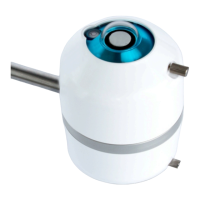EKO INSTRUMENTS CO., LTD. - Pyranometer MS-80/80S/80U - Instruction Manual Ver. 1
Pg. 27
5- 5. Measureme nts
1. Data logger settings
The output voltage is measured by a measuring device such as a voltmeter or a data logger. If solar irradiance
is measured continuously, it is recommended to use a data logger, which has sufficient memory to record data
over a longer period and functions to to process the measurement parameterss of the pyranometer. Depending
on the sensor output which will be used, the data logger should be capable to measure the assigned output
type.
For MS-80 with analog output, the datalogger should have a voltage input range (0-20mV), resolution (~1µV )
and impedance (> 100MΩ). For the MS-80S with current output, Modbus 485 RTU and SDI-12, the datalogger
should have one of those inputs. For MS-80S the input range, resolution and impedance are not critical, and
considered as standard for any meteorological or industrial type datalogger. For current measurement the
measurement range should be selected according to the range settings of the MS-80S.
When configuring the datalogger parametersce, the sampling rate and data reduction methods can be defined
right at the beginning of the data acquisition process. The response time that is given in the specifications of
the EKO pyranometers states the amount of time, which is necessary to reach 95% of the final measurement
value. It is also possible to define a 63.2% response [which is equal to 1-1/e]. This time constant, represented
by the symbol τ, is 3 times smaller than the values specified by EKO. The recommended
[1]
sampling rate for
pyranometers is smaller than τ. So, for EKO pyranometers, the sampling rates that have to be programmed in
the data logger systems should not exceed the values as given in Table 7-1.
Performing averaging and/or integration of measurement data can be meaningful to, e.g., reduce the data
volume or to meet application-specific requirement. Note that shorter sampling rates allow to use shorter
averaging/integration times [example for MS-80: 10 Hz sampling rate, 1 minute averaging period]. It could also
be meaningful to store not only average values, but to keep track of all statistical values during the averaging
period, namely: average, integral, minimum and maximum values, and standard deviation. As a general
recommendation, the averaging/integration period should be as short as possible, but long enough to reduce
the data volume to store the processed data safely.
Recommendations for irradiance measurements are explained in
[1]
“Guide to Meteorological Instruments and
Methods of Observation”, WMO reference document No. 8.

